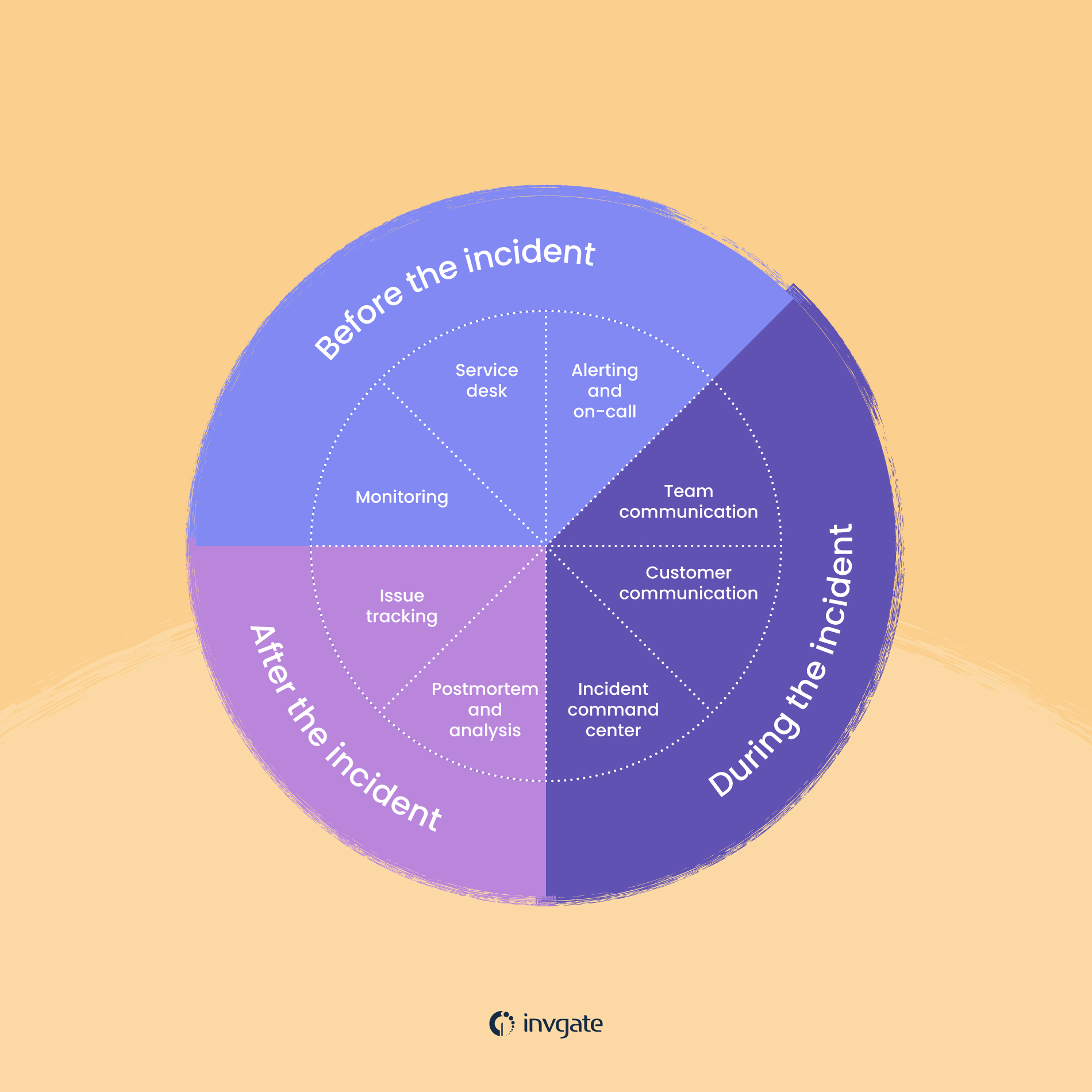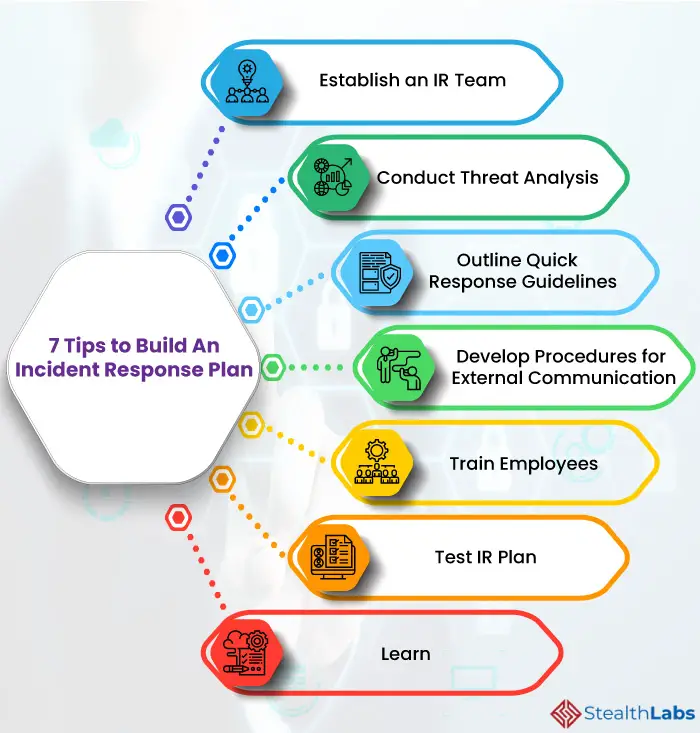Key Strategies for Effective Incident Management in Software Development

In software development, incident management is crucial for maintaining system stability, minimizing downtime, and ensuring customer satisfaction. To achieve effective incident management, various strategies can be implemented:

-
Establish Clear Incident Response Procedures: Define comprehensive procedures outlining the steps to be taken when an incident occurs. This includes incident classification, triage, communication, and resolution responsibilities.

-
Implement a Centralized Incident Logging System: Create a central repository for all incident information, including timestamps, descriptions, assigned personnel, and resolution details. This facilitates efficient tracking and documentation of incidents.
-
Empower a Dedicated Incident Response Team: Establish a team with the necessary expertise and authority to respond swiftly to incidents. This team operates 24/7 and collaborates effectively across departments.
-
Utilize Automated Monitoring and Alerting Tools: Leverage tools to continuously monitor systems for anomalies and proactively alert teams about potential incidents. This enables early detection and faster response times.
-
Facilitate Root Cause Analysis: Perform thorough root cause analysis to identify underlying issues that may have led to an incident. This knowledge helps prevent similar incidents from recurring.
-
Establish Clear Communication Channels: Ensure open and transparent communication channels between the incident response team, stakeholders, and customers. Timely and accurate updates are crucial for managing expectations.
-
Conduct Regular Incident Reviews: Schedule regular reviews to evaluate the effectiveness of incident management processes, identify areas for improvement, and update procedures as necessary.
-
Foster a Learning Culture: Encourage team members to share their experiences and lessons learned from incident management. This knowledge sharing contributes to continuous improvement and enhanced response capabilities.
-
Integrate Incident Management with Other Processes: Align incident management with other processes such as change management, release management, and DevOps to create a cohesive incident response system.
-
Regularly Test and Exercise Incident Management Plans: Conduct drills and simulations to test the incident response process and identify areas for optimization. This ensures the team’s readiness and efficiency in real-world incidents.## Key Strategies for Effective Incident Management in Software Development
Implementing effective incident management strategies is crucial for software development teams to ensure timely resolution, minimize disruptions, and provide seamless user experiences. This article explores the top 5 key strategies to help organizations optimize their incident management processes.
Executive Summary
Effective incident management is critical for software development teams seeking to maintain operational efficiency and customer satisfaction. This article presents comprehensive strategies that cover incident identification, prioritization, containment, resolution, and post-mortem analysis. By following these best practices, organizations can significantly improve their ability to manage and mitigate incidents, minimize business disruption, and enhance overall software development efficiency.
Introduction
In today’s fast-paced software development environment, incidents are inevitable occurrences that can disrupt project timelines, impact product quality, and affect business reputation. Therefore, it is essential for software development teams to establish a robust incident management process to respond effectively to unexpected events and minimize their impact.
1. Incident Identification and Reporting
Identifying and reporting incidents promptly are essential steps in incident management. Establish clear channels for users, employees, and support teams to report incidents effectively. Consider implementing automated incident reporting mechanisms to ensure timely detection and prompt action.
- Key Considerations:
- Define clear reporting channels and criteria for incident identification.
- Provide accessible incident reporting platforms for users and stakeholders.
- Enable automated incident detection and reporting through monitoring tools.
- Train team members on incident reporting procedures and responsibilities.
- Benefits:
- Timely incident identification helps prevent escalation by addressing issues before they impact the system.
- Efficient reporting systems reduce delays in response time and minimize business disruptions.
- Automated reporting eliminates human error and redundancies.
2. Incident Prioritization and Triage
Not all incidents pose the same level of risk or severity. Prioritizing incidents based on their impact and urgency ensures prompt attention to the most critical issues. Implement a triage system to categorize incidents and guide the allocation of resources.
- Key Considerations:
- Establish clear criteria for prioritization based on impact, urgency, and availability of resources.
- Use a triage system to categorize incidents efficiently.
- Define roles and responsibilities for triage decision-making.
- Perform regular triage audits to ensure consistency and effectiveness.
- Benefits:
- Prioritization helps allocate resources effectively to resolve the most critical incidents first.
- Triage systems reduce overwhelm and prevent firefighting approaches.
- Timely triage ensures rapid response and containment of high-priority incidents.
3. Incident Containment and Response
Containment and response measures aim to limit the impact of incidents and restore normal operations. Implement clear protocols for incident containment, isolation, and remediation. Establish a triage system to categorize incidents and guide the allocation of resources.
- Key Considerations:
- Define clear containment strategies to isolate the incident and prevent further escalation.
- Implement response plans for various incident types, such as system failures or security breaches.
- Designate an incident response team responsible for managing incidents effectively.
- Establish communication channels for timely updates and coordination among the team.
- Benefits:
- Effective containment strategies minimize the spread and impact of incidents.
- Response plans provide a structured guide for incident resolution.
- An incident response team ensures efficient communication and collaboration.
4. Incident Resolution and Recovery
Incident resolution focuses on restoring normal operations and addressing the root cause of the incident. Establish a systematic approach to problem-solving, including root cause analysis and corrective action implementation.
- Key Considerations:
- Use a structured approach to problem-solving and incident resolution.
- Conduct thorough root cause analysis to identify the underlying causes of incidents.
- Implement corrective actions to address the root causes and prevent recurrence.
- Perform post-mortem analysis to review incident response and identify areas for improvement.
- Benefits:
- A systematic approach guides the team towards successful resolution.
- Root cause analysis prevents similar incidents in the future and improves overall system stability.
- Post-mortem analysis provides insights for process improvement.
5. Incident Monitoring and Reporting
Continuous monitoring and reporting provide valuable insights into incident trends and help improve incident management processes. Implement metrics to track incident frequency, severity, and resolution time. Conduct regular reporting and analysis to identify improvement areas.
- Key Considerations:
- Set up metrics to monitor incident-related metrics, such as frequency, severity, and response time.
- Conduct regular reporting and analysis to track incident trends and identify areas for improvement.
- Share incident reports with relevant stakeholders, including development teams and management.
- Use reporting to drive continuous improvement efforts and ensure effective incident management.
- Benefits:
- Metrics provide quantifiable data for performance evaluation and process improvement.
- Regular reporting helps detect emerging trends and implement preventative measures.
- Reporting ensures transparency and promotes accountability.
Conclusion
Effective incident management is essential for software development organizations seeking to maintain high-quality software, meet customer expectations, and reduce business disruption. By implementing these five key strategies—incident identification and reporting, prioritization and triage, containment and response, resolution and recovery, and monitoring and reporting—organizations can create a robust incident management process that minimizes the impact of incidents, ensures prompt resolution, and drives continuous improvement.
Keyword Tags
- Incident Management
- Software Development
- Incident Reporting
- Incident Prioritization
- Incident Resolution
FAQs
What is the first step in incident management?
The first step in incident management is incident identification and reporting, which involves establishing clear channels for users and teams to report incidents in a timely and accurate manner.
What is the purpose of incident prioritization?
Incident prioritization is critical for allocating resources effectively by classifying incidents based on their impact and urgency, ensuring that the most critical issues receive prompt attention and resolution.
Why is containment important in incident management?
Containment is essential for limiting the impact and spread of incidents by isolating affected systems and preventing further escalation, allowing for the controlled restoration of normal operations.
How does root cause analysis contribute to incident resolution?
Root cause analysis is a crucial step in incident resolution as it identifies the underlying causes of incidents, enabling the implementation of corrective actions to prevent similar incidents in the future and improve overall system stability.
What is the significance of continuous monitoring and reporting in incident management?
Continuous monitoring and reporting provide valuable insights into incident trends and help improve incident management processes by allowing organizations to track incident-related metrics, identify patterns, and implement proactive measures based on data analysis.

I found the article very informative. Incident management plays a critical role in ensuring business continuity and minimizing the impact of unforeseen events on software development. The strategies outlined in the article provide a comprehensive approach to incident management, from planning and preparation to response and recovery. By adopting these strategies, organizations can effectively mitigate risks, reduce downtime, and improve the overall resilience of their software development processes.
The article fails to address the importance of clear communication and collaboration in incident management. Without effective communication channels and collaboration between different teams, it becomes challenging to coordinate response efforts and resolve incidents efficiently. A comprehensive incident management strategy should include measures to ensure real-time communication and seamless collaboration among all stakeholders involved.
The article provides valuable insights into the key strategies for effective incident management in software development. However, it would be helpful to include more specific examples and case studies to illustrate the practical implementation of these strategies. Providing real-world examples would make the article more relatable and easier to understand for readers.
While the article discusses the importance of incident management, it doesn’t delve into the challenges associated with implementing these strategies. Incident management can be a complex and resource-intensive process, and it’s crucial to acknowledge the potential obstacles organizations may face when trying to implement these strategies. A more comprehensive approach would involve addressing these challenges and providing guidance on how to overcome them.
The article’s title is somewhat misleading. It suggests a focus on key strategies for effective incident management, but the content primarily revolves around general principles and high-level concepts. I was expecting more practical and actionable advice on how to implement these strategies in real-world software development scenarios.
I couldn’t help but notice the excessive use of jargon and technical terms in the article. While it’s important to use precise language, it’s equally important to make the content accessible to a wider audience. Simplifying the language and avoiding unnecessary technical jargon would make the article more readable and beneficial to a larger pool of readers.
The article is well-written and provides a solid overview of incident management strategies. However, it would be more engaging if it included interactive elements such as quizzes or interactive simulations. By incorporating interactive components, readers could test their understanding of the concepts and gain a more hands-on learning experience.
The article seems to oversimplify the challenges of incident management in software development. Incident management is not just about following a set of predefined strategies; it requires a deep understanding of the software development process, technical expertise, and the ability to adapt to ever-changing circumstances. The article could benefit from acknowledging the complexities and nuances involved in effective incident management.
I found the article to be quite informative and practical. The strategies outlined are clear and actionable, and I can see how they could be applied in real-world software development scenarios. I appreciate the inclusion of specific examples and case studies, which helped me better understand the implementation of these strategies.
While the article provides a good starting point for understanding incident management strategies, it lacks depth and fails to address some of the more advanced concepts and techniques used in modern software development. Incident management has evolved significantly in recent years, and the article would benefit from incorporating these advancements to stay relevant.